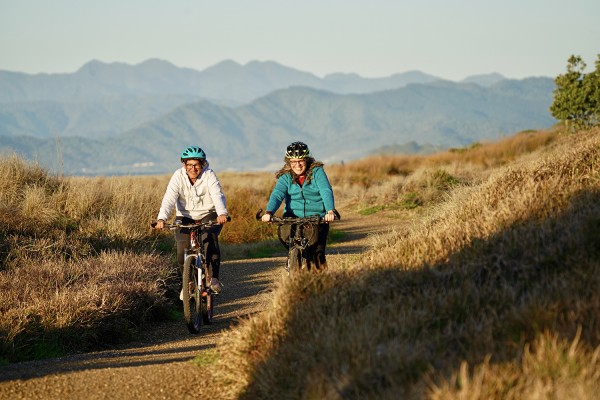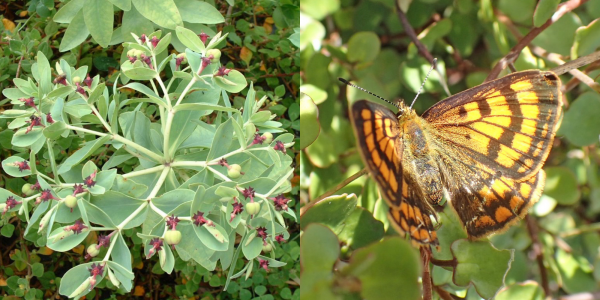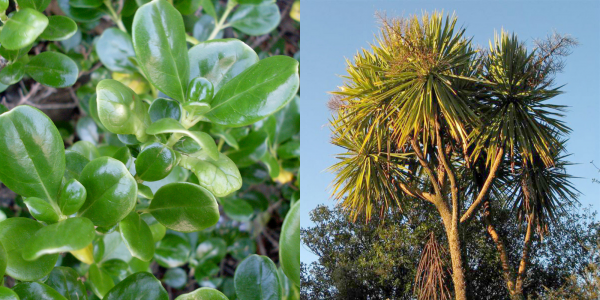Community planting on the Motu Trails
Community and cycling come together on the Motu Trails with a series of eastern Bay of Plenty planting programmes that are helping restore precious dune ecosystems back to their former glory.
This Great Ride celebrated its 10th birthday in 2022, but that's not the only milestone it reached.
Since opening in 2012 about 35 community planting days have seen more than 30,000 trees and plants dug in along the Dunes Trail section near Ōpōtiki.
Trail manager Jim Robinson is stoked with the enthusiasm and generosity of local volunteers who have carried out most of the mahi.
"A big thank you to everyone who has turned up to help – it's great for a town of under 10,000 people. We get so many helpers that all of the work is completed quickly and efficiently."
Volunteers dig in plants along the Dunes Trail (Jim Robinson).
In 2024 a big step forward was planting some of what Jim describes as "forever" trees.
In many places, a low canopy of tough species is now well-established, which means the trees that would once have featured along the coast will now survive, notably puriri and kohekohe.
"We planted about 30 in 2024, tucked away in random places beneath the ngaio and karo. It felt like, yay, we’re finally at the real stage."
In partnership with local iwi-based project Whakatōhea Tiaki Taiao, and supported through DOC community partnership funding, the trail rolled out the first stage of a predator trap line along the dunes in 2022.
Plenty of rats and mustelids are being caught.
The environmental restoration work alongside regular trail maintenance means the Dunes Trail is in tip-top shape.

Part of the beautiful section of Dunes Trail west of Ōpōtiki (Tran Lawrence).
Success stories to spot on the regenerating Dunes Trail
Two planting successes along the length of the Dunes Trail are Waiū-atua and Pohuehue. Both species are thriving and easy to see as you cycle or walk the trail.
Waiū-atua is a perennial herb that grows multiple stems with blue-green foliage and deep-red flowers. The species doesn’t look local but is it is endemic to New Zealand and the Chatham Islands. Translating loosely as "milk of the gods" because of its irritating milky white sap, it is used in Rongoa, traditional Māori medicine, to treat skin diseases.
The plant is classified "at-risk/declining", mostly due to grazing by cattle, sheep and rabbits, and habitat loss from development and erosion, plant disease and competition from introduced grasses. Until recently it was completely absent from the area.

Waiū-atua (left – iNaturalist), and the Copper Butterfly perched on some Pohuehue (right – Jim Robinson).
Pohuehue is a twisting vine that produces a dense tangle of stems with tiny leaves and flowers. It provides an excellent habitat for birds, lizards and insects, including the little coastal Copper butterflies you may see flitting about in summer.
By stopping grazing, minimising tracks through the dunes and controlling weeds, the Pohuehue is recovering superbly along the trail.
Coastal forest growing again
Much of this coast was once covered in forest, mostly low lying, but also including big trees like pōhutukawa. pūriri and karaka. The vision is to restore the environment to something like it used to be, with the following species selected for their resilience in this harsh coastal environment.
Ngaio is a tough, salt-tolerant tree found nationwide in coastal areas and low-lying forest. It grows up to 10m tall, with white flowers spotted with purple, and pretty purple berries.
Taupata is common around North Island coasts, forming a small tree or, in windy spots, a gnarled shrub. It’s also called the mirror plant due to its thick, high-gloss leaves, and produces red-orange berries which are great for attracting birds.

The shiny leaves of the Taupata/mirror plant (left), and an Aotearoa New Zealand classic Tī Kōuka/cabbage tree (DOC).
Karo grows around the North Island and can reach 10m in height. It’s another tough species withstanding long dry summers and salty winds, and has crimson coloured flowers and large seed capsules that open to reveal sticky black seeds.
Tī kōuka (a.k.a. the cabbage tree) is one of the largest tree lilies in the world, reaching up to 20m high in favourable environments. Hundreds have been planted along the Dunes Trail.

